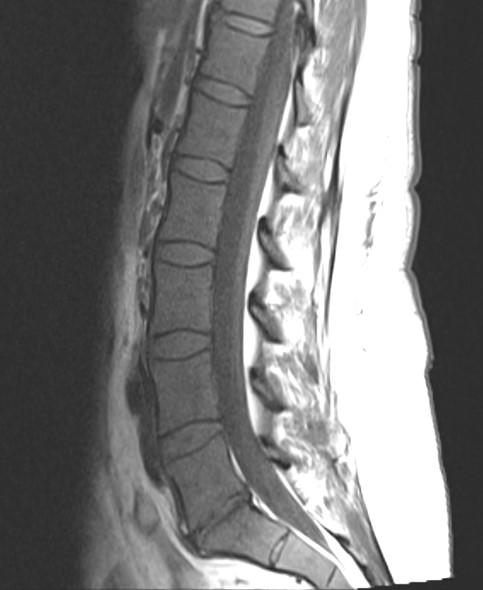Case Presentation: A 38-year-old Hispanic female with chronic constipation, anemia and numerous transfusions secondary to uterine bleeding presented to the emergency department with a two-week history of worsening bilateral lower extremity ascending numbness and weakness extending to her abdomen causing her difficulty with walking. She reported blurry vision, headaches, difficulty breathing, and 24 hours of urinary retention. She traveled to the US from Puerto Rico one month prior to presentation. The remainder of review of systems was negative. She does not take any medications and does not smoke, drink or use illicit substances. There was no family history for autoimmune disease.On physical examination, she was alert to person, place, and time. Cranial nerves were intact. Abnormal findings include decreased strength (4/5) in both lower extremities, decrease in sensation to pinprick to midshins bilaterally, and diminished right patellar reflex. She exhibited severe discoordination with bilateral heel to shin testing with preservation of upper extremity fine coordination. An unsteady, high stepping, stomping gait pattern was observed. No inducible Babinski sign noted. A smooth red tongue was present. There was diffuse abdominal tenderness on palpation without rebound or guarding. Initial laboratory values revealed macrocytic anemia with an elevated LDH and reticulocyte count. TSH, inflammatory markers, and infectious work up were unremarkable. CTA of the chest showed nodularity of the upper thymic bed. MRI of the thoracic spine revealed diffuse abnormal T2 signal involving the entire thoracic cord, primarily the central and dorsal cord, and MRI of the lumbar spine revealed a diffuse abnormal marrow signal. Upon further investigation, a low vitamin B12 level was identified with a normal folate level and elevated methylmalonic acid and homocysteine levels. An extensive immunological workup showed a positive Intrinsic Factor Blocking Antibody. Daily B12 injections were administered during her hospital stay resulting in slow but progressive improvement in her neurological deficits and gait abnormality. The patient was discharged home and was to continue B12 injections.
Discussion: The overall picture was complicated by inconsistent neurological findings, ascending weakness, severe discoordination with possible cerebellar disturbance, and unsteady, high stepping gait. On initial presentation based on history of present illness and diagnostic workup performed in the emergency department, Guillain-Barre Syndrome or a demyelinating disease were both considered as the potential etiology of her symptoms. After physical examination, other differentials were incorporated such as a mass lesion or vascular abnormality which would explain the cerebellar findings, vitamin or copper deficiency, an autoimmune disorder, infectious etiology, subacute combined degeneration, myelitis transversa, neuromyelitis optica, or malignant process.
Conclusions: Vitamin B12 deficiency is often not included in the list of differentials particularly with patients exhibiting inconsistent neurological manifestations. Because of the broad spectrum and wide variation of clinical manifestations which vitamin B12 deficiency can present as, this disorder as well as pernicious anemia are often overlooked as a differential diagnosis. When clinical findings are hematologic and neurologic in nature, one should consider vitamin B12 deficiency as the culprit.

